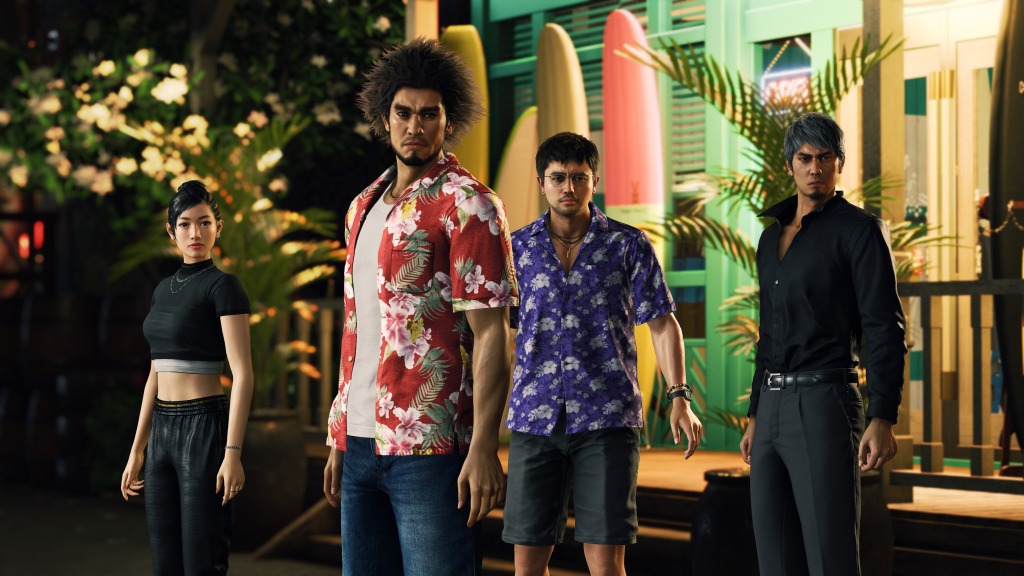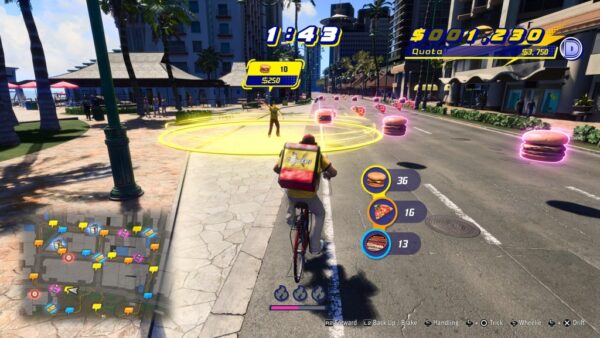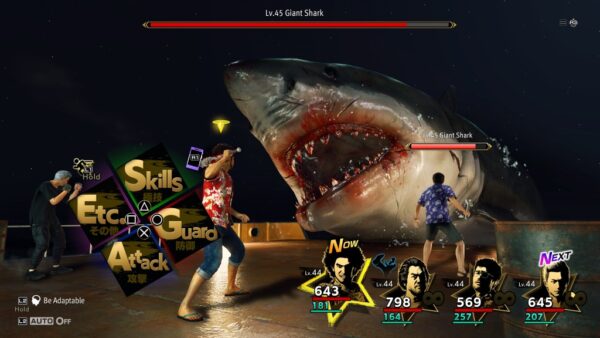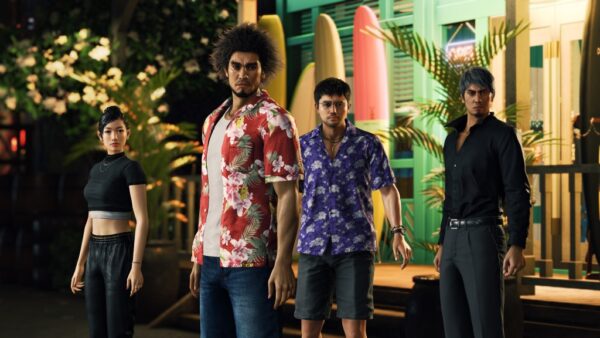Also On: PS4, Xbox Series X, Xbox One, PC
Publisher: Sega
Developer: Ryu Ga Gotoku Studio
Medium: Digital/Disc
Players: 1
Online: Asynchronous multiplayer
ESRB: M
The events of 2020’s Like a Dragon, 2 of the largest Yakuza organizations in Japan announced their dissolution, sending shockwaves in the underworld. You’d think after this scenario, a game which was formerly known locally as Yakuza wouldn’t have much of a story to tell, but in Like a Dragon: Infinite Wealth we are treated to an adventure that looms so large that it spans both sides of the Pacific. Would a team that has been steeped primarily in Japan and its culture be able to tell a tale while mired in a culture that is foreign to them?
You initially control Kasuga Ichiban, a former Yakuza who in-franchise took the baton of protagonist from Kazuma Kiryu. Unlike the stoic Kiryu, Ichiban had a childish sense of loyalty and optimism, fans took the transition well and embraced the Dragon Quest loving, wild haired oaf.
With the events of the previous title way in the rear view, Ichi has tried to continue his late father’s mission of reintegrating ex-yakuza into civilian life by working at a temp agency in his new found home of Isezaki Ijincho, Yokohama. This less than glamorous life is shattered when a V-tuber (The franchise keeps up with trends…what can I say) maliciously attributes his altruism for greed thus ruining his and his friends’ rebuilt lives. After learning of a local yakuza clan rebuilding post-dissolution, he encounters a face from his past who reveals that his long thought to be dead mother is actually alive and living abroad. He drops everything and goes across the ocean to find the mother he never knew…
While he played a minor role in the previous title, former protagonist Kazuma Kiryu returns to act as a deuteronomist. Prior to this game he starred in a side title which fleshed out his cameo in Like a Dragon and details the work he has been doing in a mysterious shadow faction known as the Daidoji. A mission serendipitously takes him to Hawaii and while monitoring police activity he finds and bails Kasuga out of a bind. Realizing that their goals align the two team up together to take on their respective missions in this foreign land.
Since Like a Dragon, the gameplay of the franchise pivoted to turn-based combat from arena-based brawling. Infinite Wealth takes the foundations of turn-based and gives it a sheen which makes it unique compared to other RPGs. The first is allowing your controllable characters a range of motion before taking their action, this allows you to get optimal effects be it damage dealt, status inflicted or health healed. Smart positioning can also allow team up attacks and as you build relationships with your party, combat can feel like a game of pinball with foes being battered left and right by your loyal companions. The second is the increase of environmental objects strewn across the battlefield. While Like a Dragon did have some objects which can be used as weapons, the lack of character movement meant that using these objects would rely completely on randomness and the effectiveness of these weapon attacks always felt lacking. This rehaul certainly helped the Infinite Wealth reclaim some of the franchises’ identity back when it was a brawler. So this means that bike owners on both sides of the Pacific better hope they purchased insurance of some sort because if it’s within reach, any ruffian looking to hinder my progress will get a face full of spokes!
The class system returns…however my following statement is not meant as a detriment to the classes to the new or old classes that return, I found myself sticking to each character’s exclusive class during the entirety of my playthrough. Perhaps it speaks to how effective those exclusive classes are or maybe the game is not exactly tuned to give you a hard time, thus I never felt the need to pivot to another class to say give other characters the option to be a healer. My neglect of the classes means I will be missing out on the unique spells and the ever wacky super attacks (Essence of…) and I’m sure if I was willing to explore a bit, my experience would’ve been richer for it.
Another departure that happened in Like a Dragon is the addition of party members. The franchise was always known for strong character work and adding party members meant there were more people to endear yourself to. From the disgraced cop Adachi, the homeless ex-nurse Namba, the barmaid Saeko, the mafia leader turned chef Zhao and the 2nd in command of the region’s Korean mafia Joon Gi, they rounded out the title and brought a dynamic that you would never find in previous entries. Only one character from the previous title didn’t return Eri (She is based on an actual person and these “face” characters tend not to return), but her absence is addressed if you go out of your way to seek it. Getting to know these party members was a treat, be it conversations about mundane things or drinking with them and learning/resolving their issues made me grow fonder of them and the game rewards you with better synergy in battle!
Infinite wealth adds two new characters and makes a non-playable character playable. Eric Tomizawa is a shifty cabbie who literally took Kasuga for a ride, but eventually is drawn to his side due to the latter’s enigmatic charisma. Chitose is another reluctant party member who teams up with the group as a means to an end, but in my opinion she ends up being the most endearing and complex character to be introduced to the franchise. The third new party member is Seonhee, the leader of the Geomijul and Liumang two thirds of the Ijin Three, the trio of criminal organizations which keeps the peace in the region. Seonhee was generally femme fatale with great leadership skills, but in Infinite Wealth we see a side of her I never expected…fan girl. It was definitely a departure from her original characterization, but I think it really rounds her out as a character in this entry. Given the fanbase’s complaints about the lack of strong female characters, the post-Kiryu games have given us a trio (Chitose, Seonhee and Saeko) that I feel shows the studio’s growth.
Speaking of growth, uprooting the franchise to the West meant RGG studios had to create a massive amount of new assets. Honolulu City doesn’t have the claustrophobic feel as Kamurocho or Sotenbori. Its pedestrian diversity is miles beyond older titles, characters of different shades, body types and even children can be seen roaming the streets of this tropical region and it really shows the difference between the melting pot of America versus the more homogenous Japan. The team manages to incorporate local brands and pay homage to iconic locations. In fact for those who wish to learn more about the real life inspirations which coalesced into Honolulu City, Washington Post Writer Gene Park will be live streaming on January 27th and will be detailing the real life inspirations that went into building this fictional burg.
Honolulu City also plays host to a myriad of side activities if you have no desire to move the main story forward. Photo rallies which urge you to explore every nook and cranny of the town. Work on building your rizz (that’s what the kids call it…right?) by meeting women online using Miss Match dating app! Sugimon Battles is quite the upgrade compared to Sugimon feature from Like a Dragon. The latter was just a bestiary whereas the former is a full blown creature battler and even features a side story which can occupy you for hours. If aping Pokemon doesn’t raise your ire, Sicko Snap has you photographing butterfly masks wearing muscle men as they make Honolulu City their playground whether the citizens want it or not. It certainly will remind you of a spin off game from the N64 era. The homages do not end there as Crazy Delivery evokes SEGA’s arcade past while mixing commentary about modern food delivery.
Dondoko Island is a resort builder sim which acts as a way to express your design aesthetics as well as a way to increase your bank account. I originally would expect to do the bare minimum, but found myself engrossed in the feature, even sticking around after I’ve completed the mode’s objectives. Franchise mainstay side activities such as shogi, darts, gambling (both eastern and western), and arcade games round out leisurely side activities.
Another side activity which will provide boons to your main story experiences would be substories and the substories-ish Life Links/Memoirs of a Dragon. Substories generally have Kasuga interacting and helping the denizens of Honolulu city, this results in scenarios that range from comedic to poignant. Finishing these substories can garner you items, potential visitors to Dondoko island and even poundmates (The game’s equivalent to summon creatures)! Unlike previous entries, the subjects of the substories end up populating the town after their events have been completed thus giving Honolulu City a more lived in feel and I certainly did appreciate seeing them in the map even if they will serve no other purpose moving on.
Life Links/Memoirs of the Dragon are Kiryu exclusive events. As a man who had to discard his life to protect his friends and loved ones, and one with his time on earth running down…these events let him stealthily catch up on all the people whose lives he’s touched in the 6+ games he starred in. I rarely praise music whenever I review games, but the music that is played during the Memoirs of the Dragon helps set the mode. These are definitely made for long-time fans, but even if you aren’t a series veteran you’ll want to complete these to bring Kiryu’s fighting spirit back to form as well as give yourself a taste of what you skipped out on. As a person who’s getting up there in age (I’m more Kasuga’s age than Kiryu mind you)…I can certainly relate to regrets of decisions not made and melancholy in the fact that people in Kiryu’s life have progressed while he remains stagnant and has no real means to reach out.
Despite the reverence and glowing matter I have been describing the title. It is not perfect, the game does rely on some large logic leaps to button up the plot. Some plot points are left hanging for way too long and conclude a little too conveniently. I also found at times Ichiban felt like a secondary character in his own game, outshined by Kiryu especially since the latter had a cancer storyline that seemed way more fleshed out than Kasuga’s long lost mom plot. While Kiryu’s tale is certainly worth telling, it diminishes the passing of the torch that happened in the last game.
Some of the game’s presentation was also head scratching, especially regarding the voice acting (Don’t worry this won’t be a screed about YongYea), it actually involves bilingual characters in the Japanese audio track. Eric, the Japanese American party member, speaks fluent Japanese, but when it comes time to speak English, it’s disjointed and not to the level of a native speaker. Another point of contention is I wish some characters would outright speak their native tongue, rather than magically have a mastery of Japanese, the biggest example being Dwight Mendez, the leader of the Barracudas…you hired Danny Trejo to voice him in the English track, I would leverage that in all audio tracks rather than just the English one. Mentally I would accept the babelfish style presentation where characters will speak in their native tongue and there isn’t a language barrier, this is something the fighting game Tekken utilizes and I don’t even bat an eye when they do it. I’m sure recording the audio tracks weren’t done in tandem, but I would expect a studio with such attention to detail would let this slip.
Another dark cloud which hangs over this paradise has been SEGA’s approach to DLC, specifically locking out new game+ and additional difficulty modes as paid DLC. I genuinely see both sides of the issue, the ever increasing cost of game development vs the gating of features that were historically included in the base title. The frustrations the fanbase is having are absolutely, even as I personally have never completed the any game in the franchise beyond my initial run…and the access I have a as reviewer usually nets me a Deluxe Edition (although as of current writing, my copy does not have access to New Game+, so I might need to wait til the title’s launch to see what access I truly have). Let’s hope cooler heads can prevail and perhaps SEGA can roll back some of their decisions and garner back some of the goodwill they had as the franchise was ascending in the West.
Despite these misgivings, Infinite Wealth is a fully packaged title that fans of the franchise will be talking about for years to come. Players will certainly be able to enjoy Hawaii as well as spend time in familiar spots in Japan. While I thought there wasn’t much that could be done in a post-dissolution world, the team crafted something that was riveting, built upon existing characters as well as introducing some fantastic new ones. I certainly will wait with baited breath to see what’s to come from the studio as well as what’s next from Ichi and the gang. While I’ve closed this chapter of the story, it’s not goodbye…it’s Aloha and certainly Bon Voyage!
Note: Sega provided us with a Like a Dragon: Infinite Wealth PS5 code for review purposes.








